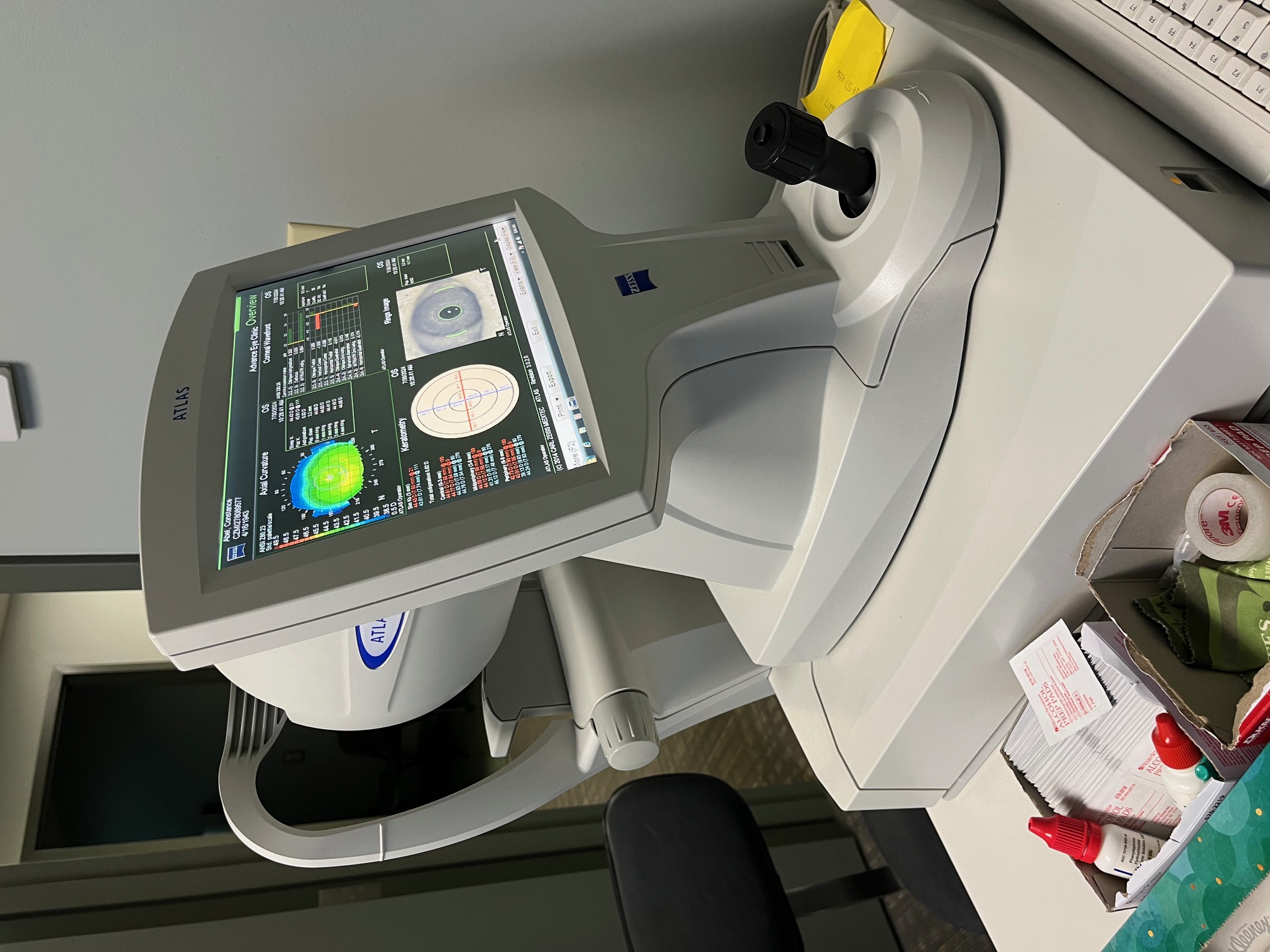Corneal Conditions
 The cornea, which is the clear covering of the front of the eye, is designed to both transmit and focus light rays as they enter the eye. There are many diseases that can affect the cornea, causing pain or loss of vision. Disease, infection or injury can cause the cornea to swell, known as edema, or degrade where the cornea becomes cloudy and vision is reduced.
The cornea, which is the clear covering of the front of the eye, is designed to both transmit and focus light rays as they enter the eye. There are many diseases that can affect the cornea, causing pain or loss of vision. Disease, infection or injury can cause the cornea to swell, known as edema, or degrade where the cornea becomes cloudy and vision is reduced.
Common corneal conditions that are treated at Eye Associates include:
Corneal Abrasion
Injuries such as scratches or cuts on the surface of the cornea are known as corneal abrasions. Corneal abrasions are painful due to the number of nerve cells in the cornea that transmit pain. The pain experienced with a corneal abrasion lets the patient know that there is a serious condition that needs to be addressed immediately.
It is important for patients with corneal abrasion to avoid touching or rubbing their eyes. In most cases, corneal abrasion can be effectively treated with no permanent complications. Often antibiotic eye drops are used to prevent infection, depending on the nature of the injury. If the cornea doesn't heal properly from an abrasion, a chronic problem called corneal erosions may occur.
Corneal Ulcers
A corneal ulcer, also known as ulcerative keratitis or eyesore, is a sore that forms on the surface of the cornea, the clear portion of the eye.
Corneal ulcers are more common in those who wear contact lenses, particularly when the lenses are not removed at night or cleaned properly. It is very important to treat corneal ulcers with the proper antibiotics promptly to prevent scarring of the cornea, which can lead to permanent loss of vision.
Corneal Erosions
Recurrent corneal erosion is a disorder of the eyes characterized by the abnormal shedding of corneal cells from its outer layer, known as the epithelium. It is often the result of an existing corneal abrasion or a disease such as corneal dystrophy (usually inherited) or diabetes. The condition may affect one or both eyes.
This condition is initially treated with a topical antibiotic ointment at night to help keep the epithelial cells attached to the cornea. Lubricating artificial tear eye drops may also be beneficial as they can keep the eye moist. Treating any underlying disease that is responsible for the recurrent corneal erosion is often very effective in resolving the erosion issue as well. In severe cases that do not respond to these measures, alternative treatment options are available.
Allergic Conjunctivitis
Allergic conjunctivitis is the inflammation and swelling of the tissue lining the eyelids and the white of the eye, the conjunctiva, in reaction to allergy causing conditions. Allergic conjunctivitis is uncomfortable but it rarely causes injury. Treatment varies depending on the cause, history and symptoms, and may include topical or oral antihistamines, topical corticosteroids or eye drops.
Ocular Herpes
Ocular herpes is a viral infection in the eye caused by the Type 1 herpes simplex virus, the same virus that causes cold sores. Treatment of herpes simplex depends upon which portion of the eye is affected and the severity of the infection. Most often treatment involves antiviral eye drops, ointments or oral medication to fight the infection.
Map-Dot-Fingerprint Dystrophy
The most common corneal dystrophy, map-dot-fingerprint dystrophy occurs when the epithelium’s basement membrane develops abnormally, and the epithelial cells cannot properly adhere to it. This abnormality leads to recurrent epithelial erosions. If it gets severe enough to cause blurry vision, an office procedure called a superficial keratectomy may help.
Keratoconus
Keratoconus is the gradual thinning and outward bulging of the cornea into a cone shape. This progressive eye condition usually affects both eyes by thinning the corneas from that of a normal rounded dome-shape into one that has a cone-shaped bulge. In those patients with keratoconus, the cone-shaped cornea deflects light and causes distorted vision.
Pterygium
Pterygium is a painless, non-cancerous growth of the conjunctiva, the lining that covers the white part of the eye. The pterygium may grow on the cornea, which covers the iris, the colored part of the eye. A pterygium usually begins at the nasal side of the eye and can be different colors, including red, pink, white, yellow or gray. If a pterygium interferes with vision, continues to grow or shows atypical features, an outpatient surgery can remove it with good success.
Conjunctivitis
Conjunctivitis, also known as pink eye, is an infection or inflammation of the conjunctiva, the membrane that lines the eyelid and covers the white part of the eyeball. The inflammation affects the blood vessels in the eye and gives the eye a pink or red appearance. Most cases of pink eye are caused by viruses similar to the common cold virus and resolve without treatment. Frequent handwashing and avoiding direct contact with an infected person's tears are necessary to limit spread of the infection. Pink eye can take several days to a few weeks to resolve. Some patients have bacterial pink eye treated with antibiotics. An eye exam can distinguish these conditions.









If you would like more information about Corneal Conditions or to schedule an appointment, feel free to fill out our convenient contact form or call us directly at 215-997-2015.